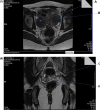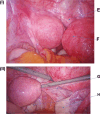A rare variant of mullerian agenesis: a case report and review of the literature
- PMID: 38523311
- PMCID: PMC10962068
- DOI: 10.1186/s13256-024-04438-x
A rare variant of mullerian agenesis: a case report and review of the literature
Abstract
Introduction: Menstruation is a developmental milestone and usually marks healthy and normal pubertal changes in females. Menarche refers to the onset of first menstruation in a female. The causes of primary amenorrhea include outflow tract abnormalities, resistant endometrium, primary ovarian insufficiency, and disorders of the hypothalamus, pituitary, or other endocrine glands. A rare variant of mullerian agenesis, which warrants an individualized approach to management, is presented here.
Case report: We present here the case of a 25-year-old Indian female with pain in the lower abdomen and primary amenorrhea. After a thorough history, clinical examination, imaging, and diagnostic laparoscopy, two small uteri, a blind upper half vagina, bilateral polycystic ovaries, and a blind transverse connection between the two uteri-a horseshoe band cervix-were detected, which confirmed the diagnosis of mullerian agenesis. There was evidence of adenomyosis in the mullerian duct element. This is a rare form of Müllerian abnormality with an unusual presentation.
Conclusion: Mullerian agenesis is the most common cause of primary amenorrhea with well-developed secondary sexual characteristics. There are various forms of mullerian agenesis. Most of the cases are managed by a multidisciplinary team. Rare variants warrant an individualized approach to management.
Keywords: Case report; Mayer–Rokitansky–Kuster–Hauser syndrome; Mullerian agenesis.
© 2024. The Author(s).
Conflict of interest statement
The authors declare that they have no competing interests.
Figures


References
-
- ACOG Committee Opinion No. 651. Menstruation in girls and adolescents: using the menstrual cycle as a vital sign. Obstet Gynecol 2015;126(6), e143–e146. 10.1097/AOG.0000000000001215 - PubMed
-
- Klein DA, Emerick JE, Sylvester JE, Vogt KS. Disorders of puberty: an approach to diagnosis and management. Am Fam Physician. 2017;96(9):590–599. - PubMed
-
- Welt CK, Barbieri RL. Causes of primary amenorrhea. https://www.uptodate.com Accessed 20 Nov 2022.
Publication types
MeSH terms
Supplementary concepts
LinkOut - more resources
Full Text Sources
Medical

